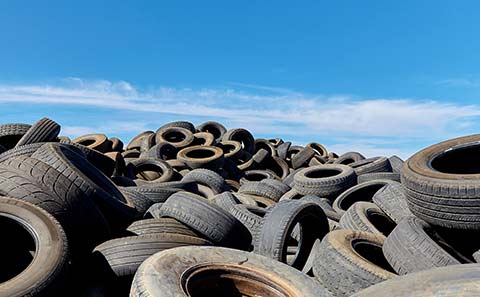
Today’s good winter tires perform at a level that was unthinkable three and four decades earlier.
How’d they got to be so good?
It takes more than the right shape to make tread effective on snow and ice. Winter tires reflect decades of development—in shape, tread pattern and rubber compounds.
Drivers often forget that in winter driving, stopping ability is more important to safety than the traction provided to get accelerated in snow and on ice. An early 2000s study done for the State of Washington notes that in one set of stopping tests in Alaska, performance on snow was nearly equal for studded, modern studless, and all-season tires. On the ice, however, stopping distances for studded tires were 15 percent shorter than for studless Bridgestone Blizzaks, and stopping distances for the Blizzaks were 8 percent shorter than for all-season tires.
Here are some highlights in decades of development of the winter tire:
1930s—Snow Treads for Trucks
In Finland, where roads weren’t very good and winter weather was worse, Nokian made sure delivery trucks could handle endlessly snowy roads with its first Hakkapeliitta snow tires. The first winter treads, designed for trucks, were narrow with big horizontal blocks for bite. They might have been lame by today’s standards, but in the mid-1930s they were a huge winter driving improvement.
1940s— Snow Treads for Cars
By now the big boys got into the act. Winter treads from Goodyear, Firestone, Dunlop and others became available for cars. They relied on aggressive treads designed to deliver an extra bite.
1950s—Sawdust, Walnut Shells
Retreads gained traction—quite literally—with 1950s winter drivers in the Midwest. The retreads had new skins imbued with sawdust or tiny bits of walnut shells. As the tires wore down, the sawdust and walnut particles also wore and fell out, creating a porous tread surface with thousands of tiny edges that gripped snow, even if it was packed.
Sound silly? It wasn’t. History repeated in the 1990s when Bridgestone introduced the highly effective Blizzak winter tire, with a synthetic compound that has a porous makeup, creating tiny traction edges as the tire wears. Toyo still uses walnut shells in its Observe line.
Goodyear and Firestone sold millions of their snow treads in the 1950s—Goodyear’s Suburbanite and Firestone’s Town & Country—relying on aggressive lug-type tread designs.
1960s—Studs Bite Into Ice
The big U.S. manufacturers of the decade introduced studded tires. The studs, the makers promised, were made of extremely hard metal—but would wear at the same rate as the rubber tires. Uh, didn’t happen, of course. But those studs did grab packed snow and ice when they weren’t eating highways.
Resultant highway damage led to limits on studded tire use. In the United States, only Colorado, Kentucky, North Carolina, Vermont and Wyoming allow year-round studs use. Alabama, Florida, Louisiana, Michigan and Texas allow only rubber studs. Canadian provinces that do not restrict studded tire use are Alberta, Northwest Territories, Saskatchewan and Yukon.
1970s—Asymmetric Snow Treads
Snow tires weren’t known for their handling, just for their ability to get your car through snow. Asymmetric treads on snow tires had one side of the tread intended for better handling and the other aimed at deep snow. They worked well.
1980s—Improved Slush, Water Dispersal
The Hakkapiliitta NR 09 introduced the arrow-shaped directional tread. It did a better job of carrying slush away from the tire tread, improving wet-weather traction. Similar tread patterns have ben adapted by many winter tire manufacturers.
1990s—Ice Traction Without Studs
Studless technology began to eclipse metal studs for traction on ice and packed snow, without degrading dry-road and wet-road grip and without damaging road surfaces. Bridgestone made strides with the Blizzak’s porous tread and Nokian improved tire grip by 40 percent with its high density of zigzag sipes on tread blocks.
2000s—Tread Flexibility
Snow tires in the 21st Century have become more effective as manufacturers have combined several technologies: slush- and water-extracting tread patterns, heavy siping, a zigzag sipe shape for increased traction edges, and environmentally friendly oils in compounds to improve traction. Compounds with silica remain more flexible in freezing weather, improving grip on snowy, icy, dry and wet roads. The new compounds also helped to give some snow tires higher top speeds that, when combined with improved tread patterns, improved handling.
See the selection of winter tires on tiremart.com.
See our separate blog on recommended winter tires for 2019-20.


